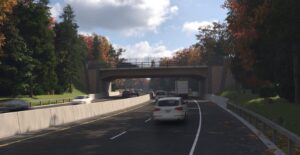
Wider lanes, a breakdown lane, on-off ramps, new overpasses and improved drainage along Route 9A between Ossining and Briarcliff Manor are among the preliminary concepts in a $2 million study on modernizing the overburdened roadway.
The state engineering report follows a pair of workshops focused on a 5.5-mile stretch of what’s also known as the Briarcliff-Peekskill Parkway, a roadway dating from the 1930s that accommodates 48,000 vehicles daily.
The Department of Transportation’s study area encompasses the corridor stretching from the Route 9/Route 9A split in Ossining to the Taconic Parkway ramps in Briarcliff.
Among the concepts under consideration:
- Entire corridor: Lanes widened from 11 to 12 feet; 8-foot-wide breakdown lane; center concrete barrier; bridges raised to accommodate commercial vehicles.
- Stormytown Road/Hawkes Avenue/Route 134: Adds or replaces bridges; adds on-off ramps and service roads at intersections.
- Route 133/Ryder Road: Adds new bridges and on-off ramps.
- Route 100/Pleasantville Road: Creates a roundabout near Carlton Avenue. An undersized bridge that’s routinely struck by trucks will be replaced with one that’s at least 13 feet high. Replaces bridge over Pocantico River to alleviate flooding.
- A second alternative subsequently presented by the DOT for the Pleasantville Road/100 intersection calls for standard on-and-off ramps from both roads as well as adding a new bridge.
- Chappaqua Road: Adds a bridge over 9A, eliminating the traffic light. Drivers who now can only make a right turn at Pleasantville Road would be able to go left or right.
- North State Road: Eliminates traffic signal in favor of either a bridge over Route 9A or an underpass beneath 9A. Either option would provide on-off ramps.

A draft summary outlining preferred concepts will be completed by mid-January, which will be open to public comment before the study is completed in February.
The next step would be seeking funding for a preliminary design of the improvement plans before moving toward construction.
‘A great first step’
Little has changed over the years along the state roadway, whose designers didn’t anticipate the commercial traffic nor the passenger vehicles that now pack the north-south corridor.
Briarcliff Mayor Steven Vescio, a member of the Transportation Partnering Committee providing input on the project, called the concepts “a great first step.”
“It’s more attention than that roadway’s gotten in 50 years, when they installed the guiderail in the 70s, and there’s deficiencies that are noted here that the state is ultimately on notice for,” Vescio said in December. “I certainly don’t think they’d spend $2 million in taxpayer money and ignore the results of that, especially when there’s been such public involvement. There were over 100 people at the last public workshop.”
Vescio was among the local officials who announced funding for the study in April 2022. The mayor has long demanded the state find solutions for the neglected roadway, noting the dozens of accidents and damaging flooding that occurs each year along the 2.5-mile stretch in Briarcliff alone.
“It’s simply a miracle that more people haven’t been killed or injured,” he said during an April 29 press conference.
View the plans and comment
- Click here to view the concepts, which can also be viewed at Briarcliff Manor Village Hall.
- Send email to Sandra Jobson at Sandra.Jobson@dot.ny.gov to comment on the concepts.






